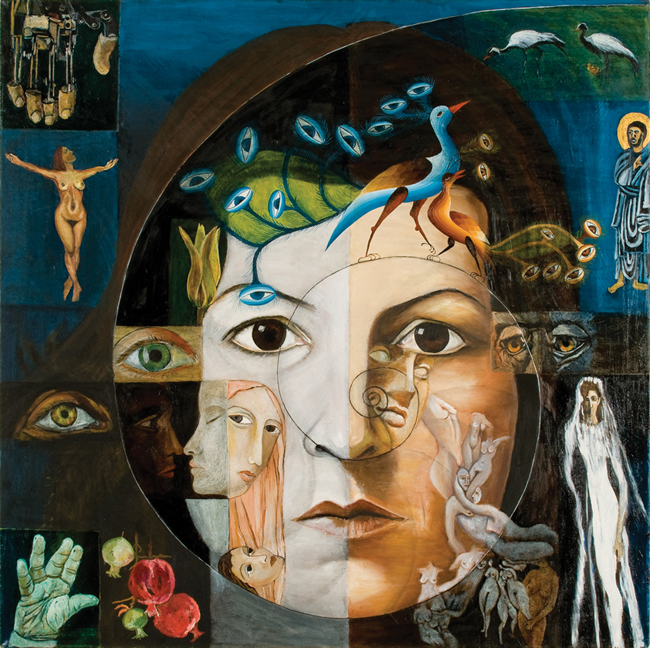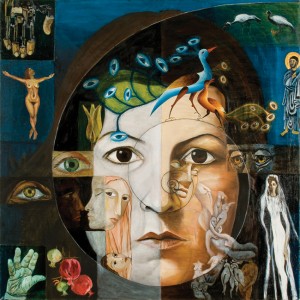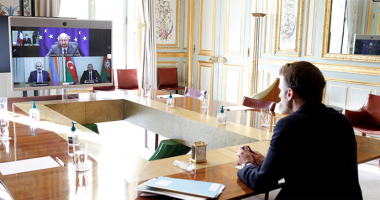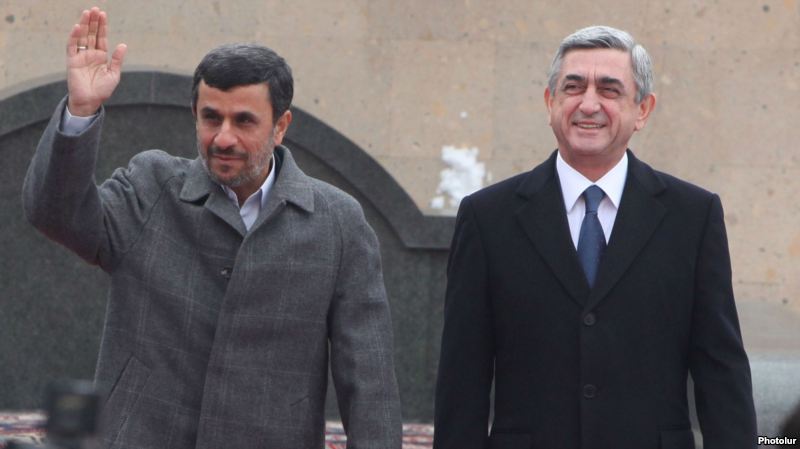By Sahag Toutjian
Long overdue, the first, high quality album of the prominent Armenian-American painter Seeroon Yeretzian has just been published by Abril Publishing, 415 E Broadway, Suite 102, Glendale, California (Telephone 818/243-4112) in December 2011. Seeroon is one of the most talented avant-garde Armenian painters of contemporary Diaspora, and the present album of 200 pages of reproductions in authentic colors compiles the best of her creative art to date. We firmly believe that she promises to surprise her national and international admirers with ever more consummate new masterpieces of her unique art style. The following essay is an amendment of the author’s review in 1991 covering Seeroon Yeretzian’s pioneer exhibition of paintings in April 19991.
At the first glance upon entering the exhibition hall, your senses are stirred with perplexity. You pass in front of the canvases. At first indistinctly, then more clearly, your self-assurance begins to falter. Your thoughts refuse to take refuge in their deceptive initial equanimity. The accepted formulations on art become rather irrelevant and superfluous. Here we are dealing with the real world: rough, brute and merciless. Here, also, we are dealing with a specific art of painting that arcs itself over the world, with love and compassion, to portray it with a genuine expression of feelings and experience.
First and foremost, one is impressed by the audacity Seeroon Yeretzian displays in the selection of themes and the diversity of aesthetic experimentation. She scrutinizes, she probes, and she questions hardened “realities.” She explores personal, novel parallels of depth and form. She tries to speak entirely new idioms of the artistic language – albeit maintaining creative authenticity and truthfulness.
With her, this simple aesthetic principle is once more confirmed: The common denominator of all authentic artistic creation, regardless of the different modes of styles and expressions, is the distinctly individual expressive innovation, or, to use a popular term, an inimitable self-stamped “signature.” This means that it is possible to accomplish genuine artistic formulation of the self same given reality in both figurative and abstract execution.
The stylizations of painterly expression are numerous and diverse. It is possible to communicate in the limited ‘tongue’ of duplication or replication, more or less reminiscent of photography. It is possible to offer the essence of appearances in sharp abstraction. But it is also possible – as in Seeroon Yeretsian’s case – to lead the process of abstraction not to its supreme or utmost level, but only to the point necessary for expressive forcefulness, while at the same time maintaining a meaningful communion and immediate interaction with the outside world. Both of these two components are equally important for best appreciating her art. On the one hand, certain stylistic leverages of abstract art assist immensely in her expressive consummation. On the other hand, her communion with the real world helps her express in a dynamic intimation truths that are commonly deprived of their civil rights.
Seeroon Yeretzian’s works display a responsible and healthy stance toward unhealthy human and public situations. The injustice, ugliness and deformities of social life are her themes – and the object of her “silent” indignation. Her canvases tend to be artistic constructs hoisted against them.
The theme of “women’s rights” is the most immediate motivating force of her creative efforts. But this leads her not to feminist repudiation, but to the inclusive attitude of humanism. In numerous works this horrible social condition is underlined – both woman’s and man’s concurrent exploitation and crucifixion, the inequality of them both, which is a result of the same prevalent inhumane conditions. She raises this issue through all the palettes she employs in her canvases. The crucified woman, her helpless male mate, relegated to the background in his muscular absurdity, the two other females or “thieves” crucified on the flanks – or, in another instance, the two children who animate the frontal plan – all join together on the modernized symbolic cross.
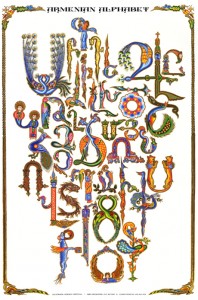

The second important theme dominating the canvases is human suffering and deprivation, man’s humiliation by man and man’s inhumanity towards man. Here, manifested are the Armenian Genocide on the one side, and the American homeless on the other.
The works dedicated to the Armenian Genocide are expressions of profound tragedy, powerful emotions. These clay skulls have been brought to the canvas with such infinite tenderness! Bodiless heads. Headless bodies. Otherworldly faces, hollowed eyes and bones. The canvas frame is unable to contain so much inhumanity – so that within the picture a special frame is provided, wherefrom overflow the torrents of tragedy, with the heaviness of dark blue, the eruptions of scorching red, the outburst of a sad green reminiscent of death rather than life. In another part of the canvas, the contents of the inner frame and the space outside it dissolve into each other to become one.
In numerous works, the bleak, shameful themes of the homeless tower up like an immense question mark against the sneaking self-alienation of American democracy. The series of contorted canvases depicting an old woman dragging life’s vanity, turned into an unbearable leaden burden, along cold sidewalk pavements, is a pointed indictment of this modern grotesque fiction called civilization. (With bitter irony, the old, old phrase “to grow old gracefully” comes to mind.) Rough and deadly are the cobblestones where the figure of a youth or the blunt juxtaposition of the lively colors of two exquisite dolls is spread like a lifeless gray lump of flesh. This depravity is a betrayal of man’s rationality against man. “Home, Sweet Home.”, 1983, is an inscription under the extremely poignant, shocking image of a desperate homeless person.
In the string of themes brought to the canvas, prominent importance has been allocated to social vices: deceit (masks, masks, masks), the social humiliation of women, the enervating claws of a deceptive civilization (and the annihilation of refreshing childlike spontaneity by the tie-clad gray establishment), Armenian and non-Armenian contemporary scenes, the all-pervading melancholy and the wingless hope hardly stirring at times, and finally, the oblique solace offered by the creative passion of art.


At the focus of Seeroon Yeretzian’s oil paintings, one often finds the fiery trinity of red-orange-yellow, whose tense dynamism is counterbalanced by the thick black of the background. Besides this, the occasional white renders the theme more salient, as with the white faces of the three women which are contrasted to the neon colors wrapping their up-for-sale bodies. On a second plane one notices the hues of rust and especially an unwholesome green which so aptly imparts meaning to the given moment. A gray or black gloom, which expresses the dark tragedy in leaden hues, comes to further enhance the impressions. Brown, gray and black are commonly dominant in the case of acrylics. These, however, are at times mellowed down by the light white of the background, and in some instances, blaze up with the glitter of gay shards of rainbow colors.
The harmonious symbiosis of colors and hues find their culmination in the gouaches. In this connection, it is worth to note the ornamental letters of the Armenian alphabet, which invoke the authentic colors and hues of our miniature art heritage.
We should not forget the pencil and pen drawings which animate objects and situations.
Seeroon Yeretzian creates under the immediate stimulation of her psyche, conceptions and fantasy. Honesty renders to her forms of expression a fresh immediacy and a keen emphasis which best illuminates the inner spiritual vistas of the artist. The series of chilly masks, in eloquent yet restrained communicativeness, symbolizes her unequivocal stance against personal hypocrisy and social deceit.
One can attribute the essential aesthetic qualities of Seeroon Yeretzian’s paintings to the cinfluence of the best traditions of German expressionism – specifically, the potency of emphatic and bold black or dark lines, the employment of color generally as a means to display emotional states; the preponderance of heavy colors (black, brown, etc.) for expressing emotionally and authentically the harsh mercilessness of life. Her creations exhibit the keen perception of the uncertain fate of contemporary aimless man, the profound grasp of inner human aspirations, and the robust dynamism of unyielding audacity of modern thinking in search of answers.
June-July 1991
English translation by the author 10 October 2010

